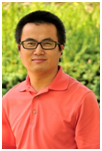中法核工程与技术学院第102期学术午餐会
Insight into structural materials: application of in-situ synchrotron X-ray scattering on materials characterization and discovery
中法核工程与技术学院第102期学术午餐会
102nd Academic Lunch Seminar of Sino-French Institute of Nuclear Engineering and Technology
Topic: Insight into structural materials: application of in-situ synchrotron X-ray scattering on materials characterization and discovery
Speaker: Dr.MENG Fanqiang(孟凡强)
Time: 12:40 – 14:00, FridayMarch8, 2019
Venue:F309in the teaching building, Zhuhai Campus, SYSU
Organizer: Sino-French Institute of Nuclear Engineering and Technology, Sun Yat-sen University
Language: English

Abstract:
Synchrotron X-ray scattering has become a popular technique to characterize the structural evolution as a function of temperature, stress, magnetic field and so on. One of representative application is the investigation of phase transformation sequences in amorphous materials. Clarification of crystallization pathway is not only helpful for the structural design, but also can provide important insight into the starting amorphous structure. Two Al-Sm amorphous structures realized in melt-spun ribbons (MSR) and magnetron sputtered thin films (STF) exhibit very similar structural order, as measured by HR-TEM and HE-XRD; yet these two structures devitrify following vastly different pathways. The MSR alloy exhibits a polymorphic transformation to the “big cubic phase” (BCP), while the STF develops pronounced compositional inhomogeneities before the formation of fcc-Al and “big hexagonal phase” (BHCP). In both cases, the initial devitrifying transition consumes the entire sample, after which the resulting crystalline phases follows different pathways. Both pathways eventually converge toward the same phase composition. The difference in the structural motifs between BCP and BHCP and its relationship to an atomic “Gene” in the starting amorphous structures of the MSR and STF is discussed.
About the speaker:
Dr. MENG Fanqiang, associate professor at IFCEN, Sun Yat-sen University, received his Ph.D. degree in Material Science and Engineering from Tsukuba Universityin Match 2013. During this period, he mainly studied the use of strong plastic deformation to control crystal and amorphous structure in order to achieve the strengthening and toughening of structural materials. He did his post-doctoral researchfrom April 2013 to January 2014 in Japan and from February 2014 to January 2019at Ames National Laboratoryin the United States.















 中法核工程与技术学院
中法核工程与技术学院 中法核工程与技术学院
中法核工程与技术学院